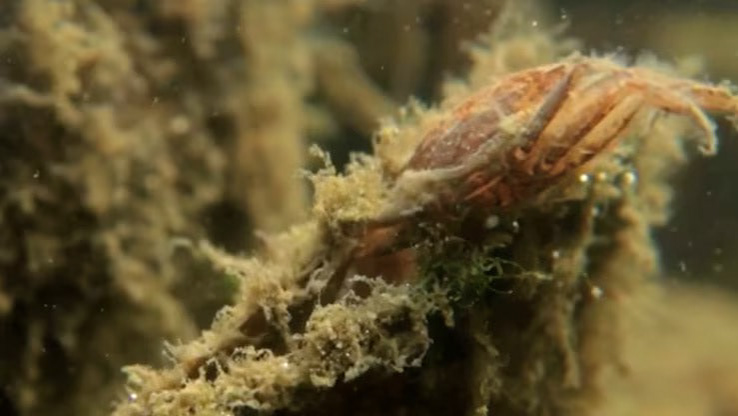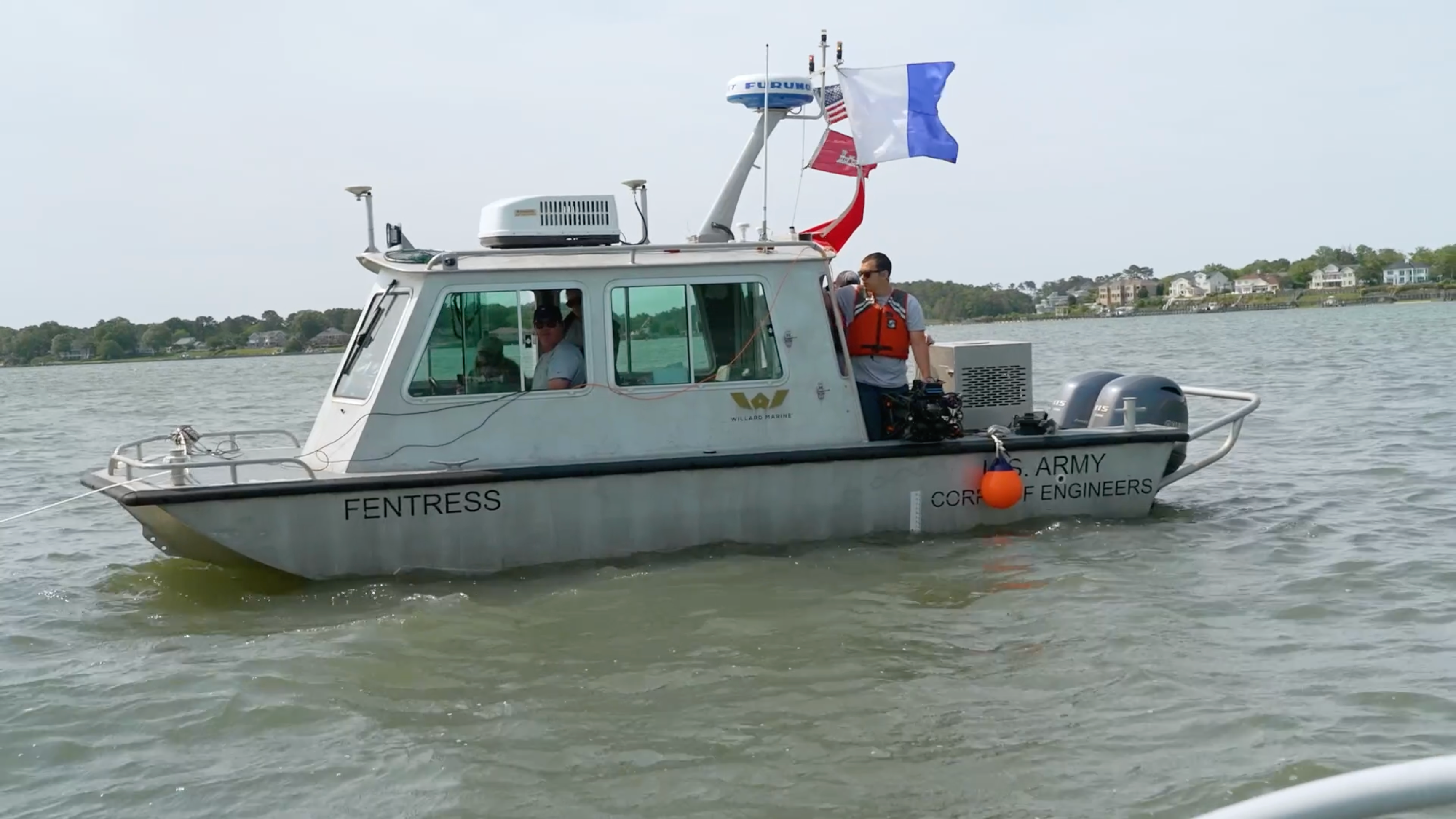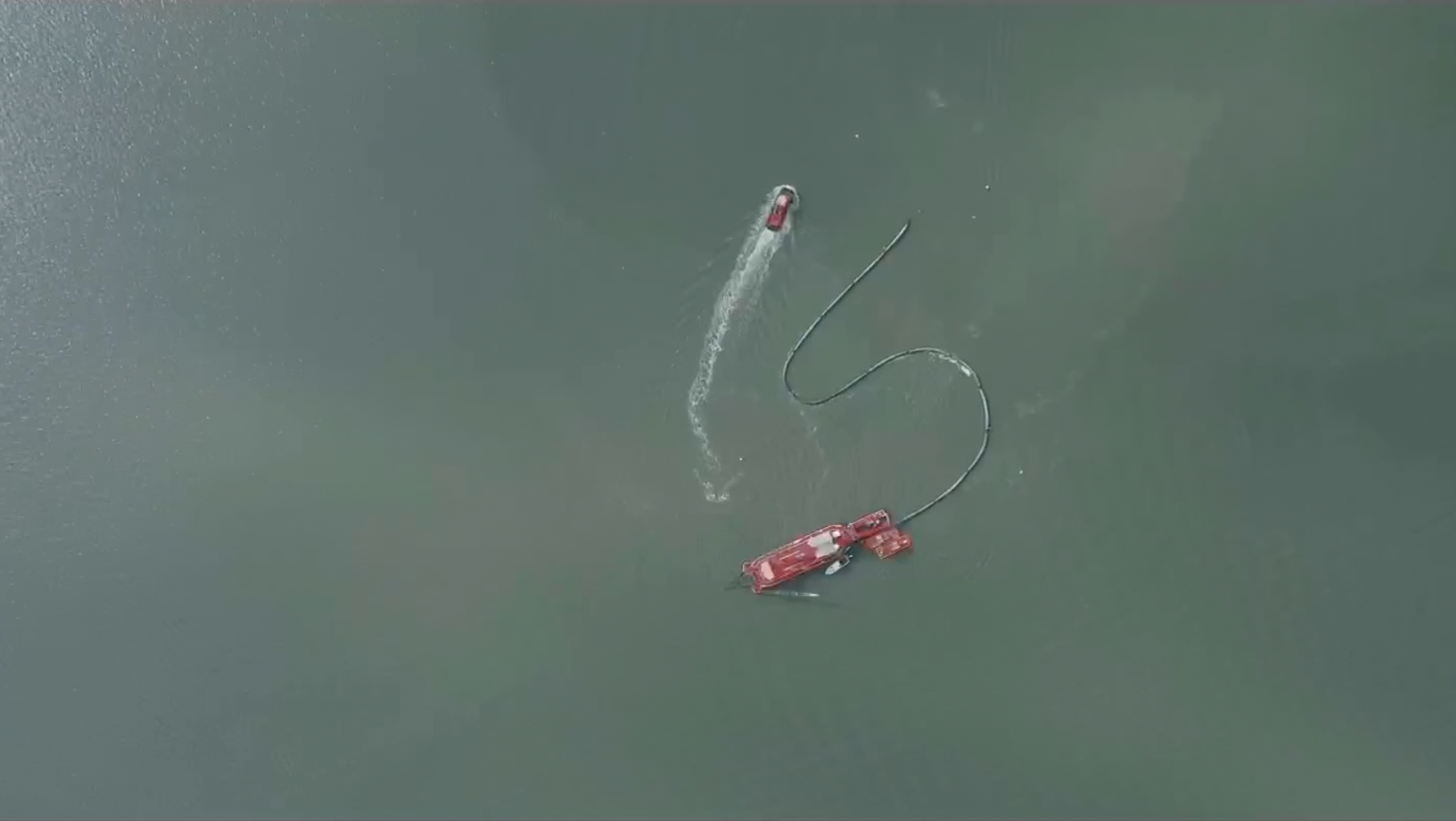The Lesner bridge, an expansion of Shore Drive, allows traffic to cross the inlet where the Chesapeake Bay and Lynnhaven River meet.
HAMPTON ROADS, Va. — In a world grappling with the ecological and climatic ramifications of a century of swift population growth and environmental degradation, communities and governments are beginning to find common ground in projects designed to heal our planet. On April 17th, 2024, students at Princess Anne High School in Virginia Beach routinely set out into the wetlands to conduct monitoring of the wetland restoration efforts in Thalia, showing the community that even the youngest can have an impact and personally benefit when the community comes together to solve a problem. This wetland restoration effort comes as part of what is known as the Lynnhaven River Basin Ecosystem Restoration Project (LRBERP), a collaborative effort between the U.S. Army Corps of Engineers (USACE) and the City of Virginia Beach.
According to, Gina Dotolo, a USACE Biologist and leader of the wetlands restoration aspect of the project, the overall goal is to restore the health of the Lynnhaven River, which in turn helps improve the water quality of the Chesapeake Bay and quality of life of all who use it. Gina continues, explaining that this engagement is essential for fostering future environmentalists and restoration experts. "They [the students] live and grow up here and I like that they're really involved in this site because it helps get the younger generations interested in saving their environment.”
Thanks to a collaborative partnership with USACE and local organizations, Princess Anne High School Science Teacher Katie Liakos uses an "outdoor laboratory" for hands-on environmental science education. This partnership ensures students can engage directly with the Lynnhaven River Basin restoration site. "It really just solidifies that what we are teaching has meaning and impact, something you can use later on," Liakos explains.The U.S. Army Corps of Engineers will monitor this site for the next 10 years before handing over responsibility to the City of Virginia Beach, guaranteeing sustained access to this practical learning resource for future students.
Jim Milliken, the Water Quality Improvement Manager for Va. Beach, emphasizes the significance of the city's partnership with USACE, saying, "Since 2003, this partnership has not only focused on restoring the Lynnhaven River Basin but has also integrated environmental education within our public schools. This initiative ensures that our investment in the environment is carried forward by future generations who actively participate in our ecological programs and city council boards." This approach, he notes, is foundational for sustainable ecosystem restoration.
Background:
Globally, we are witnessing an acceleration in sea level rise, largely due to climate change and its impact on melting ice caps and thermal expansion of the oceans. This rise presents significant challenges, notably for coastal communities. Locally, in the Chesapeake Bay, environmental concerns have evolved dramatically over the years. Historically plagued by pollution and habitat loss, concerted restoration efforts led by USACE and partners have been crucial. Projects include oyster reef restoration and water quality improvements, which not only support biodiversity but also enhance the resilience of local communities against the consequences of rising sea levels.
Meet Kathy Perdue, a biologist and wetland technical lead with the U.S. Army Corps of Engineers (USACE) Norfolk District. In this video, Kathy and biologist Gina Dotolo conduct a year-one evaluation of the Thalia Creek wetland restoration site as she explains why she truly enjoys working for the Corps.
The Lynnhaven River Basin Ecosystem Restoration Project, aimed at revitalizing the health of the Lynnhaven River in Virginia Beach, has been ongoing for several years. Historically, the river was so polluted that its fish and oysters were inedible. Thanks to the combined efforts of the City of Virginia Beach, USACE, and organizations like Lynnhaven River NOW, the river has seen significant improvements. Key components of the restoration include: wetland restoration, submerged aquatic vegetation (SAV), and hard oyster reef restoration.
In a collaborative effort with the U.S. Army Corps of Engineers (USACE) and the City of Virginia Beach to increase water quality and strengthen the diversity of wildlife habitat, scientists from the Virginia Institute of Marine Science (VIMS) transported viable eelgrass (Zostera marina) and widgeongrass (Ruppia maritima) seeds to Broad Bay, Virginia Beach for planting on January 30th, 2024. This action comes as part of the restorative efforts of the Lynnhaven River Basin Ecosystem Restoration Project.
While wetland restoration aim to restore high-quality wetlands that cleanse and store runoff before it enters the river the reestablishment of SAV provides crucial habitat for fish and marine life while enhancing the overall water quality through the filtration of excess nutrients. At the same time, the hard reef habitat initiative involves constructing additional reef structures that offer vital surfaces for sessile organisms and protective shelters for various motile species like crabs and shrimps. The oyster reefs support filter-feeding organisms which also contribute positively to the river's ecological health.
A mixture of eelgrass (Zostera marina) seeds and crushed shell to be distributed in Broad Bay, Virginia Beach.
The Lynnhaven River's restoration journey began in 2005, with significant progress noted since its presentation to the City of Virginia Beach in 2009. The project, endorsed by a 1998 U.S. House of Representatives resolution and aligned with WRDA Executive Order 13508 and the 2014 Chesapeake Bay Agreement, names the Chesapeake Bay a national treasure and focuses on improving water quality and restoring native habitats, aiming for a ecosystem recovery by 2025.
One of Dr. Russ Burke's reef ball samples from the Lynnhaven River, displayed at Christopher Newport University, showcasing efforts in ecological restoration.
Dr. Russ Burke, a researcher from Christopher Newport University focused on environmental sciences, emphasizes the interconnectedness of tributaries in the Chesapeake Bay system. He points out that the health and activities in one tributary can significantly affect others. Burke advocates for focusing on tributaries to enhance the overall health of the Chesapeake Bay, which is crucial for both ecological balance and the operational readiness of strategically important facilities like the Norfolk Naval Base. His approach highlights how targeted improvements in individual tributaries can lead to broader positive impacts across the entire Bay area, essential for both commercial and military activities in the region. The podcast below highlights importance that oyster reefs have on the entire ecosystem and the importance of increasing individual awareness and participation in the efforts to restore the health of the area we call home.
According to Dr. Burke, the Bay's oyster populations have historically demonstrated a tendency to act as a cohesive meta-population, interconnected through ecosystems like the Lynnhaven River, the Elizabeth River, and Harris Creek. Before the 1600s, these systems were naturally supportive of one another, adapting and thriving together through various environmental changes. However, today we face a fragmented system, leading us to adopt a localized approach to restoration.”
Burke continued, saying "our current restoration efforts are a test bed for applying our scientific knowledge on a larger scale. With significant resources being invested, we're hopeful that the benefits of these efforts will extend beyond state borders, demonstrating the interconnected impacts of environmental restoration between Maryland and Virginia.”
Va. Senator Bill DeSteph hosted a series public meetings in Virginia Beach in 2023 where discussions unfolded around initiatives to restore the Lynnhaven River and its tributaries through the introduction of oyster reefs and aquatic vegetation. The following video highlights the dialogue between the U.S. Army Corps of Engineers, the Virginia Institute of Marine Science (VIMS) and the residents of the Broad Bay Area, regarding SAV specifically. Near the end of the recording, there is an interesting question and answer session with the most frequent significant questions being, "why does this NEED to happen?" and "why does this need to specifically happen here our backyards?"
During the engagement, USACE and VIMS both provided explanations as to how the SAV aspect of the Lynnhaven River Basin Ecosystem Restoration project works synergistically with the others to improve water quality and biodiversity in the river and Chesapeake Bay. They addressed community concerns about the duration, funding, and safety implications of these projects, under the guidance of the Water Resources Development Act (WRDA).
So, what caused this issue?
As Dr. Burke pointed out in the podcast, the events and conditions within one tributary of the Chesapeake Bay often affect not only adjacent tributaries but the entire Bay ecosystem. Since the late 1800s, the Chesapeake Bay Area has seen a decline in water quality due to agricultural activities, urban stormwater runoff, and sewer drainage. Although the local governments began to address some of these issues during the 1990s, the negative effects were severely measurable, with boat captains in the Hampton Roads area harvesting significantly fewer bushels, dropping from millions to just a few thousand as seen in the infographic below.
This infographic shows the History of oyster populations decline and restoration within the Chesapeake Bay. Data provided by the Chesapeake Bay Partnership.
Dredging methods have also definitely played a major historic role in the decreased health of the Chesapeake Bay and surrounding waterways since the early 1900s as business attempted to enhance the path for large vessels to maneuver through the waterways. Increased infrastructure was a necessity to facilitate human livelihood and development. The economy of both the Commonwealth of Virginia and the Nation depended on such practices and they still do today.
In fact, the Port of Virginia (POV) contributes to the import of cargo to Virginia, the export of Virginia-made goods and the distribution of import of goods for sale throughout the state and across the nation. In fiscal year 2021, the POV significantly contributed to the economic vitality of Virginia despite challenges from the COVID-19 pandemic and supply chain disruptions. According to a report by the Raymond A. Mason School of Business at the College of William & Mary, the port's strategic use of technology and resilience planning enabled it to handle substantial cargo volumes efficiently. In a single year, the port:
- Generated $100.1 billion in output sales.
- Contributed $47.4 billion to Virginia's Gross State Product (GSP).
- Produced $27.2 billion in labor income.
- Supported 436,667 full- and part-time jobs.
- Generated $2.7 billion in state and local taxes and fees.
The port serves as a crucial maritime gateway for the import and export of freight, significantly influencing the Commonwealth’s economy. Most of the economic benefits, ranging from 83% to 85%, were driven by imports used as intermediate inputs in manufacturing and distribution within Virginia and beyond. Between fiscal years 2018 and 2021, the port saw increases in cargo tonnage, sales output, GSP, labor income, job creation, and tax contributions, highlighting its growing economic influence. Every dollar of POV-related impact on Virginia's GSP also generates approximately 5.8 cents in state and local revenue, further underscoring the port's critical role in the regional economy.
So how do we maintain our ability to build while facilitating the recovery of our environment?
The U.S. Army Corps of Engineers (USACE) plays a critical role in supporting both infrastructure and the economy by managing and overseeing dredging activities crucial for navigational safety and commercial efficiency. This is particularly vital in areas like Chesapeake Bay, home to the Norfolk Naval Base—the largest naval base in the world—where dredging ensures that the waterways are deep enough for the safe operation of military and commercial vessels. Through their comprehensive dredging manual, the USACE prioritizes environmental sustainability by employing the least environmentally damaging practical alternatives. At the same time, this approach includes measures such as creating underwater berms and artificial reefs to mitigate the adverse effects of dredging on marine ecosystems, such as the historical decline in oyster populations.
By balancing these ecological considerations with the economic and national security imperatives, the USACE effectively supports both the country's infrastructure and its economic vitality, while also contributing to national security. In the video below, Virginia Congressman Bobby Scott, Port of Virginia Executive Director Stephen Edwards, Virginia Maritime Association Executive Director David White, Assistant Secretary of the Army for Civil Works Michael Connor, City of Virginia Beach Vice Mayor Rosemary Wilson, and USACE - Norfolk District Commander Brian Hallberg came together during the Norfolk Harbor Deepening project's Atlantic Ocean Channel Phase II groundbreaking ceremony to celebrate the partnered effort to ensure the channel becomes wider, deeper and safer while effectively navigating the various environmental considerations during the project feasibility study process.
Col. Brian Hallerg, commander of the USACE - Norfolk District, emphasizes the importance of ecological considerations in their projects. Speaking on the environmental implications of harbor deepening, he noted, "While we're eager to progress, we can't simply dive in and start altering things without prior research. Every civil works project we undertake begins with a feasibility study. This is a crucial phase where we collaborate with partners to gather data and explore all potential outcomes as we address a challenge. It’s also the time when we involve the public, seeking their input.”
In a later interview, Col. Hallberg further confirmed that the Corps has to rely on information from National Oceanic and Atmospheric Administration (NOAA) for accurate Mean Sea Level Rise (MSLR) projections in order to appropriately plan for currently ongoing Coastal Storm Risk Management (CSRM) projects. He emphasized that, "successful outcomes depend on successful partnerships; the more we communicate and gather information, the better equipped we are to implement solutions that are both safe and effective for everyone. We always consider the environmental impact. For instance, in this project, the sand and sediment extracted from the harbor are repurposed to replenish oceanfront beaches, which naturally helps reduce the impact of coastal storms and flooding in the local area."
At wider glance…
On a larger scale, increased human population growth and activity have had measurable effects to our global ecosystem, contributing to current sea level changes. This has been measured by NOAA, using a 19-year averaging process of tracked mean sea levels and their trajectories. Furthermore, National Aeronautics and Space Administration (NASA) research suggests that human-induced global warming, primarily from the emission of greenhouse gases through burning fossil fuels, agriculture, and deforestation, plays a significant role. This warming leads to sea level rise in two main ways. Firstly, higher global temperatures, particularly at the poles, cause glaciers and ice sheets to melt, adding more water to the oceans. Secondly, as the ocean water warms, it expands—a process known as thermal expansion—which further increases sea levels.
According to scientists at Virginia Tech's Earth Observation and Innovation (EOI) Lab, funded by NASA, the U.S. East Coast faces a dual threat from rising seas and sinking land. This combination is advancing quickly enough to endanger infrastructure, farmland, and wetlands, crucial to the livelihoods of tens of millions residing along the coastline. As a result, certain cities such as Norfolk, Virginia find themselves at greater risk of flood damage caused by hurricanes and other coastal storms.
In response to the devastating impact of Hurricane Sandy in 2012, Congress enacted legislation directing the Corps of Engineers to undertake comprehensive studies and report on flood risks in areas affected by the hurricane. The North Atlantic Coast Comprehensive Study, conducted by USACE, pinpointed Norfolk as one of nine high-risk areas requiring detailed investigation into storm risk management solutions. The subsequent Norfolk Coastal Storm Risk Management Study assessed the city's flood risks and evaluated both system-wide and site-specific risk management solutions. The study proposed a $1.4 billion initiative that includes storm-surge barriers, floodwalls, a levee, tide gates, and pump stations, projecting annual net benefits of $122 million through reduced storm damage and enhanced economic resilience. This proactive approach is crucial as Norfolk faces the dual challenge of natural subsidence and climatic changes, positioning it as a frontline city in the fight against rising coastal threats.
So what can be done to restore balance?
NASA states that human activity has already led to significant climate changes, and further changes are inevitable and that if we were to cease all greenhouse gas emissions immediately, global temperatures would start to stabilize in a few years. However, temperatures would remain significantly higher for centuries. This delay between our actions and their effects is typically less than a decade. However, it might still be possible to prevent or minimize some of the most severe consequences of climate change by implementing a dual strategy of mitigation and adaptation. Mitigation involves curbing the emission of greenhouse gases into the atmosphere, while adaptation means adjusting to and living with the climate changes that are already inevitable.
However, reexamining the wetlands monitoring at Princess Anne High School in Virginia Beach, Virginia, and the collaborative efforts of experts from Christopher Newport University, Virginia Institute of Marine Science, USACE, local city leadership, and high school students, suggests the potential addition of a third tier in addressing climate change: community involvement in environmental restoration efforts as many habitats naturally play a crucial role in filtering the environment and facilitating ecological recovery.
Madison Bair, a student at Princess Anne High School, passionately describes her involvement in the wetlands monitoring project as a transformative experience. "I actually want to become a wildlife conservationist, so this restoration and conservation is something that's really important to me," Bair states. Her participation has not only deepened her commitment to environmental stewardship but has also aligned closely with her academic pursuits in environmental studies. For Bair, each day spent in the wetlands is a step closer to her future career, reinforcing the practical impact and personal significance of her hands-on learning experiences.
This map shows the area of current state and federal partnerships for environmental restoration in the Chesapeake Bay through USACE. The RED markers represent hard reef habitat restoration. The GREEN markers represent current wetlands restoration efforts. The YELLOW markers show beach renourishment sites which leverage processed dredged materials. The BLUE markers show submerged aquatic vegetation restoration sites. Finally, the PURPLE markers show current CSRM effort sites within the Bay Area. Please click the link below to access the map directly.
The National Oceanic and Atmospheric Administration (NOAA) highlights the critical role of healthy wetlands in combating climate change, explaining the these ecosystems filter pollutants, protect against floods, and store significant amounts of carbon. The NOAA stresses the importance of partnerships across various sectors to protect and restore these vital habitats, pointing out the broad ecological, community, and economic benefits of such efforts as seen in the case of Hampton Roads.
Click HERE to explore an X-List with news from NOAA and many other agencies who participate in and monitor environmental restoration efforts within the Hampton Roads area.
For more information, regarding USACE environmental restoration efforts in the Chesapeake Bay, click HERE.










